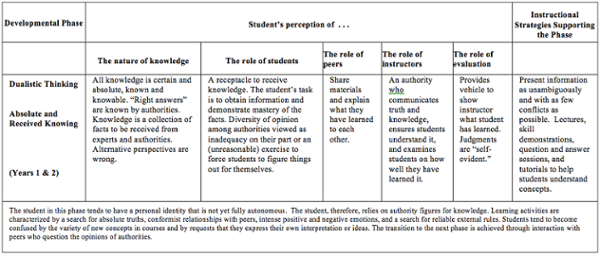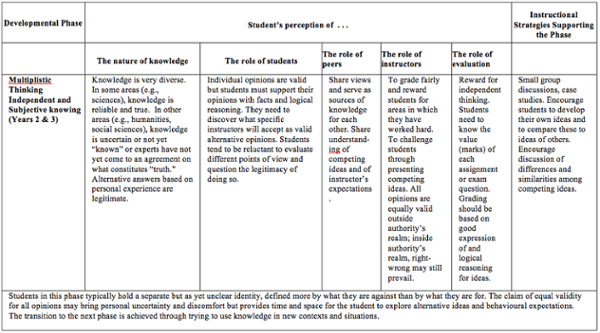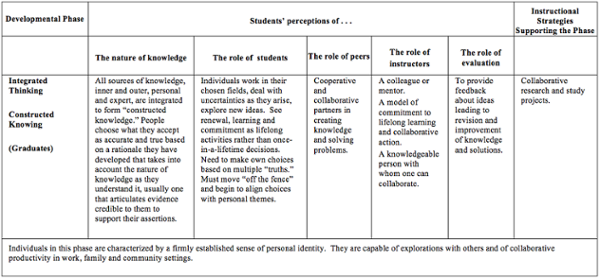Student intellectual development stages
By considering students assumptions about the nature of knowledge, we can select teaching methods that help nudge them from lower-level understanding to higher ones, commonly thought of as developing critical thinking. See table 1 for details of Perry’s Intellectual Development Scheme.
Students begin by thinking there is one correct answer for everything, and their mission at university is to find it, usually as imparted by authorities (instructors). They get frustrated when instruction moves from instructors telling them things and them taking notes and reproducing the ideas on an exam, to such things as discussion and group work, which wastes time from their point of view because other non-knowledgeable people are just spouting incorrect information.
Being exposed to different perspectives creates a certain amount of uncomfortable cognitive dissonance for them. They may decide that some topics have correct answers and others do not, but will have such answers when enough experts have investigated them and determined the correct answer.
When faced with conflicting “correct answers” by experts, students may come to see some areas of knowledge being settled (with known correct answers) and others as unsettled or unknowable. When further exposed to such conflicts, they may decide that knowledge is relativistic, that “correct answers” may vary depending on assumptions the experts make, and these assumptions reflect values supported by conviction, not objective observation or knowledge. Often they slip to the other extreme from which they started in which they see “knowledge” as “opinion” and therefore everyone’s opinions are more or less equally valid.
Over time, they may come to develop an approach to knowledge that accepts what is accurate (hard sciences) and true (social sciences, the arts, philosophy) as being based on their scheme for evaluating the evidence to support assertions, being aware that they have such a scheme and being comfortable that it is rationally defensible and the best way to understand how the world works.
So what, you may ask. Well, instructors can use this insight to better understand students concerns about teaching methods and how best to justify them in terms students will best understand, given their stage of intellectual development. Also, instructors should use teaching methods that help students understand how they understand, and challenge them to move to more mature ways of looking at the world.
Here are some ways of doing so:
Help students connect new knowledge to their existing understanding of the topic. Introduce a new topic by reviewing background and prerequisite information, noting common misconceptions and explaining why they are inaccurate. Also, connect each topic to the course outcomes or learning objectives and explain what you expect students to know and be able to do after having explored the topic.
Connect topics to fundamental concepts and underlying principles.
Provide sufficient organization, content chunking and pacing to assist students in “processing” the information. Help students develop a strong conceptual framework that they can use to organize information into meaningful patterns. Students in introductory courses are more likely to want yes-or-no answers, and some may have little patience for open-ended discussions or alternative ways of looking at issues. Show evidence that supports alternative interpretations of facts. When providing feedback on student work, be explicit about your criteria and evidence so see your comments as substantial and not just “your opinion.” This also models good methods of inquiry and analysis.
Give students opportunities to demonstrate what they have learned and what they can do with this knowledgethrough question and answer, discussion, assignments, reports, etc. on which they receive timely, substantive feedback. Provide specific pointers and focus on one or two items at a time, helping students see the destination, the path, and the next immediate steps, rather than overwhelming them with everything you think they need to work on at once. Constructive critique and evidence of progress will motivate students to learn and persevere.
Model to students how to generalize, apply, and transfer what they have learned to different contexts.
Use examples from everyday life or from student experience to illustrate the impact of concepts in ways that matter to students.
Keep workloads and schedules manageable so students can think about what they learn.
Use several ways of explaining and demonstrating the concepts that students struggle with the most,especially explaining misconceptions and inconsistencies that work against their mastery of the concepts.
Explicitly explain different approaches to knowledge (levels of intellectual development) and why they are useful. Keep in mind, though, that one’s underlying understanding of reality is something that is arrived at indirectly, through experience and reflection and not directly through explanation.
Help students move beyond yes/no, either/or thinking by exposing them to a variety of points of view based on the same evidence. This is also true for “hard sciences” and engineering, about which students need to reflective on how the discipline measures and categorizes its perceptions of experience and how the underlying assumptions of these measuring and categorization schemes may affect observations and conclusions. Challenge common assumptions and clichés. Ask for evidence to support assertions; hypothesize how people with alternative interpretations of the same phenomena and facts can come to be convinced they are correct.
“Walk” students through the evaluation of different points of view. Explore why some are logically stronger than others; help students understand why authorities disagree; identify criteria for evaluating conflicting viewpoints. Divide arguments into component parts; discuss the relative validity of different types of evidence, and explore the value-laden components of what we consider “validity.” Discuss how to make decisions when information is uncertain. Encourage probabilistic statements, while exploring the underlying assumptions about why it’s helpful to use probabilistic statements.
Work through students’ identification of and challenging of their preconceptions. Learners tend to place new material in the framework of what they already know about the subject. When new material conflicts with students’ earlier understandings or beliefs, they may distort the new information so that it fits into their existing framework. Ask yourself, What do they know? What don’t they know? What might they mistakenly believe they know (e.g., not know that they don’t know)?
Be sensitive to struggles students have as they rethink the way they think. Some empathy and guidance help in coping with conflicting viewpoints and dealing with uncertainties. Dogmatic students may need respectful help in seeing the validity of others’ points of view; indecisive students may need help in forming judgments; some who think they “got it” may be complacent without realizing it and need to thinking skeptically about some things they comfortably cling to.
Reassure students that there is no shame in changing one’s mind after weighing well-reasoned arguments—in fact, that is a sign of maturity and growing capacity for critical thinking.
Where possible and appropriate, incorporate real-world experiences into your courses. Hands-on activities, service learning, internships, or fieldwork provide help students make connections between abstract and concrete learning, and may help students develop a more complex approach to learning.
Alert students to key points (“Now, this is really critical”) and explain what they are expected to learn. Limit each class to a manageable amount of new information (e.g., three or four key points). It’s better to explore fewer topics in greater depth over the term rather than cover many topics superficially, in terms of providing deep learning and analytical skills students can use to master other, related knowledge. Try to tailor your examples to your students’ interests and backgrounds, and encourage students to relate a new topic to what they already know.
Provide frameworks within which to fit new information. This will help students develop and refine their own versions of them. Use outlines, study guides, and other aids to help students see and use conceptual frameworks and systems. Focus on key concepts, and use vivid stories and memorable examples to demonstrate key concepts.
Appreciate that learning is a highly idiosyncratic process. Because learning involves personal perceptions of the learning situation, constructions of meaning, and prior learning experiences, there is great variety in how students learn and how long they take to learn. These differences are even greater when the new knowledge is abstract and complex. Furthermore, students do not progress uniformly. Rapid progress may be interspersed with long plateaus of slow growth. Research also suggests that men and women may respond differently to certain types of teaching methods, with women finding small-group discussion and experiential learning activities more effective. (Davis, p. 263)
Try to address misconceptions about learning. Some students are hindered by their own beliefs about their ability, such as “I can’t do math,” or “I can’t write worth anything.” These create emotional barriers and anxieties that interfere with learning. Also unhelpful is the mistaken idea that learning simply “happens” without effort or perseverance, so the first time a student meets with frustration or failure, it means they can’t do it and should move on to something else. Try to maximize students’ passion for the subject and minimize their anxieties. Encourage students to keep a learning journal (reflections on what and how they are learning) or a learning agenda (what they need or want to learn and a plan of action).
Table 1: Stages of intellectual development and instructor response(MacKeracher)



References
Davis, B. G. (2009). Tools for Teaching. San Francisco: Jossey-Bass.
Love, P.G. (1999). Perry’s Intellectual Development Scheme. New Directions for Student Services. No. 88, Winter. Jossey-Bass.
